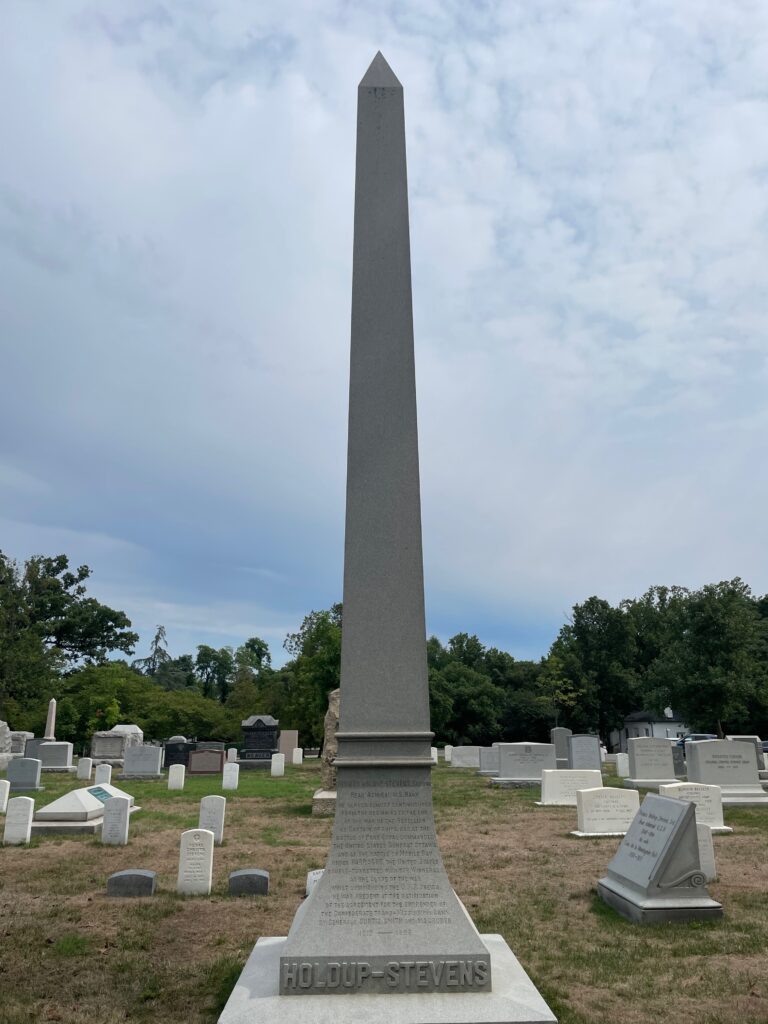Erik Visits an American Grave, Part 1,691
This is the grave of Thomas Holdup Stevens.

Born in 1819 in Middletown, Connecticut, Holdup-Stevens was a Navy kid. His father, Thomas Sr., was a well-known officer in the War of 1812. So he followed his dad into the Navy in 1836. Mostly he was on shore though. After a few years on various ships, he got a position at the Depot of Charts and Instruments, then was at the Washington Navy Yard, and did surveying in New York. All this led him to the Naval School in Philadelphia. He officially became a passed midshipman there, and mostly continued in surveying. He was also in Hawaii for a few years. But in 1855, the Navy dropped him, not because of anything he did, but because the Navy was small and he was deemed unnecessary.
This all of course changed when the South committed treason in defense of slavery. He actually had rejoined the Navy as a lieutenant in 1858. During the Civil War, he served on a number of ships. Commanding the Ottawa, he played a key role in the capturing of several forts along the South Carolina coast and in going up the St, John’s River in Florida. This all happened early in the war, as the South lost a lot of their ports quite quickly, critical pieces of Winfield Scott’s Anaconda Plan to squeeze the traitors into submission.
By 1862, Holdup-Stevens was working in support of George McClellan’s failed Peninsular Campaign, once again showing that the general was all talk and no action. Holdup-Stevens was promoted to commander in mid-1862 and once captured five Confederate ships in a 34 hour period. In 1863, he was moved to commanding the ironclad attempting to take Charleston, which didn’t work, but still was key to the Union strategy. He ended his major war action with his involvement in the taking of Mobile in 1864.
After the war, Holdup-Stevens stayed in the Navy and was a lighthouse inspector, which is not exciting but is important. And let’s be honest, what did the 19th century Navy really have to do? Not much! The Navy in the 19th century is simply not very interesting. I’m not even trying to troll Farley here, though he may disagree. He was promoted to captain in 1870 and commodore in 1873, commanding the Norfolk Navy Yard. He made rear admiral in 1879 and commanded the Pacific Squadron from August 1880 to May 1881, when he retired from the Navy.
Holdup-Stevens died in 1896. He was 76 years old.
In 1942, the Navy named the USS Stevens after Holdup-Stevens and his father. It was a destroyer.
Thomas Holdup-Stevens is buried on the confiscated lands of the traitor Lee, Arlington National Cemetery, Arlington, Virginia.
Yep, that means that because of your donations, I was able to get back to Arlington recently. I have a lot of good graves, almost all of which are more interesting than this guy. These are old donations I grant you, because no one donates to this series anymore, but hey, I get it.
If you would like this series to visit other American naval officers, you can donate to cover the required expenses here. John Paul Jones is in Annapolis (makes sense) and Chester Nimitz is in San Bruno, California. Previous posts in this series are archived here and here.


